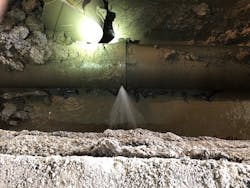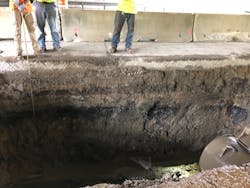Averting Disaster: Leak Detection
About the author:
Deron Austin, P.E., director of water management solutions for Mueller Water Products. Austin can be reached at [email protected].
DuPage Water Commission (DWC) in Northern Illinois purchases water from the Chicago Water Department and delivers it to 29 municipalities within DuPage County. As the second largest water supply system in the state of Illinois, DWC serves more than 900,000 residents. With close to 200 miles of water mains, DWC has experience managing leaks and pipe bursts that can occur around the clock.
Recently, a leak occurred underneath a major highway overpass. To complicate matters, water was appearing on both sides of the road in multiple locations. The pipe was under 6 inches of asphalt and 12 inches of concrete, so DWC was keen to quickly and accurately pinpoint the leak, isolate that section, reduce excavation limits, and minimize site disturbance.
“We needed to get it right the first time so we could avoid unnecessarily removing excess roadway material and minimize traffic disturbances on a high-volume area,” said Bill Wegner, pipeline construction coordinator of DuPage Water Commission.
Choosing a Sound Solution
M.E. Simpson, a technical services firm that specializes in water loss and control, was called to come out as soon as possible and pinpoint the leak location using Echologics acoustic leak detection technology. Carlos Covarrubias, Regional Manager for M.E. Simpson was onsite to do the inspection.
“At the time of the call, I only had the LeakFinder-ST, which is best suited for pipes of all material types up to 16 inches in diameter”, said Covarrubias.
This correlator uses advanced signal processing and acoustic sensors to locate leaks, including quiet narrow-band low frequency leaks. It has an automatic noise filter, which is important when taking a reading next to a highway, and a high accuracy velocity calculator identifies leaks on any pipe material.
“The pipe in question was a 24-inch ductile iron pipe (DIP) which, based on its larger diameter, is better suited to the EchoShore-M leak detection technology,” Covarrubias said. “I asked for that equipment to be express shipped to the location, but as I had the LeakFinder-ST in my truck, I thought I would take a reading to compare against the EchoShore-M when it arrived. The two readings were 10 feet apart, and the leak was right in the middle of the two, proving that both technologies were equally successful.”
Wenger noted this helped get workers on site quickly to fix problems.
“Once equipped with the knowledge of our leak’s location, we were able to dispatch our field crews to get it isolated and then repaired in short order,” Wenger said. “Chasing a leak in this environment was out of the question. We were pleased with the leak location results, which made the repair more efficient and ultimately saved our organization time, money, and resources. So, when we found out that we had a new leak further down the line, management did not hesitate to call back M.E. Simpson for an even more challenging identification.”
The location was challenging because the 24-inch DIP water main dove down 20 feet to go under a creek. Additionally, there was a 60-foot wide cast in place box culvert and a 4-lane highway with which workers had to contend.
DWC suspected that the new leak may have happened as a result of high pressure on the backside of the initial isolation exacerbated by elevated water demands as a result of an extremely hot and dry August.
“This time, more than ever, we needed to know where the actual leak was, as it could mean a significant difference on where to dig and how to attack the repair with such a challenging and sensitive location,” Wegner said.
Acoustic Leak Detection in Use
There were two possible correlation points to shoot from. First, hydrophones were attached to two air release valves 3,894 feet apart to get an idea of which side of the Commission’s blow-off valve the leak would be. Hydrophones are more sensitive and can be placed further apart than surface-mounted sensors
“Once we got that point-of-interest (POI), we set up the short correlation with surface sensors mounted 2,190 feet apart,” Covarrubias said. “We hoped that the second correlation would put us within a few feet of the first correlation and confirm the point with confidence. It so happened that this was not the case. The short shot came up about 100 feet away from the first pin-point.”
Upon review of the two correlating points, Covarrubias said they found 3,894 feet to be the best of the two options.
“The peak looked much better and so was the correlation score, along with a few other factors. I had Echologics engineers review our data the next day and they agreed on the analysis even though the sensors were much further apart,” Covarrubias said.
DWC determined the best course of action for repair was to line the pipe as the leak ended up underneath the box culvert. Armed with the POI for the leak, DWC isolated the pipe section and sent a camera into the pipe at the closest access point to learn more about the leak.
“We found a fist sized hole in the pipe and, since the pipe section was isolated, we could see ground water entering the pipe,” Wegner said. “The POI that the EchoShore-M identified over 3,894 feet was within 4 feet of the leak.”
DWC was able to fix the leak within days of suspecting there was a new leak. By finding and fixing the leak quickly, the team reduced the damage it would cause for the system and community. Given the location of the leak under a highway and a creek, time and precision were of the utmost importance.

